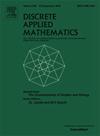Circulant TSP: Vertices of the edge-length polytope and superpolynomial lower bounds
IF 1
3区 数学
Q3 MATHEMATICS, APPLIED
引用次数: 0
Abstract
We study the edge-length polytope, motivated both by algorithmic research on the Circulant Traveling Salesman Problem (Circulant TSP) and number-theoretic research related to the Buratti–Horak–Rosa conjecture. Circulant TSP is a special case of TSP whose overall complexity is a significant still-open question, and where on an input with vertices , the cost of an edge depends only on its length . The edge-length polytope provides one path to solving circulant TSP instances, and we show that it is intimately connected to the factorization of : the number of vertices scales with whenever is prime and with whenever is a prime-squared, but there are a superpolynomial number of vertices whenever is a power of 2. In contrast, the more-standard Symmetric TSP Polytope has roughly vertices. Hence, for Circulant TSP, a brute-force algorithm checking every vertex is actually efficient in some cases, based on the factorization of . As an intermediate step, we give superpolynomial lower-bounds on two combinatorial sequences related to the Buratti–Horak–Rosa conjecture, which asks what combinations of edge lengths can comprise a Hamiltonian path.
循环TSP:边长多面体的顶点和超多项式下界
基于循环旅行商问题(Circulant TSP)的算法研究和与Buratti-Horak-Rosa猜想相关的数论研究,我们研究了边长多面体。循环TSP是TSP的一种特殊情况,它的总体复杂度仍然是一个重要的有待解决的问题,其中在一个顶点为{1,2,…,n}的输入上,边{i,j}的代价只取决于它的长度min{|i−j|,n−|i−j|}。边长多面体提供了求解循环TSP实例的一条路径,我们证明了它与n的分解密切相关:当n是素数时,顶点的数量随n的变化而变化;当n是素数的平方时,顶点的数量随n的变化而变化;但当n是2的幂时,顶点的数量是一个超多项式。相比之下,更标准的对称TSP多面体大约有n!顶点。因此,对于循环TSP,基于n的因数分解,在某些情况下,检查每个顶点的蛮力算法实际上是有效的。作为中间步骤,我们给出了与Buratti-Horak-Rosa猜想相关的两个组合序列的超多项式下界,该猜想询问边缘长度的哪些组合可以组成哈密顿路径。
本文章由计算机程序翻译,如有差异,请以英文原文为准。
求助全文
约1分钟内获得全文
求助全文
来源期刊

Discrete Applied Mathematics
数学-应用数学
CiteScore
2.30
自引率
9.10%
发文量
422
审稿时长
4.5 months
期刊介绍:
The aim of Discrete Applied Mathematics is to bring together research papers in different areas of algorithmic and applicable discrete mathematics as well as applications of combinatorial mathematics to informatics and various areas of science and technology. Contributions presented to the journal can be research papers, short notes, surveys, and possibly research problems. The "Communications" section will be devoted to the fastest possible publication of recent research results that are checked and recommended for publication by a member of the Editorial Board. The journal will also publish a limited number of book announcements as well as proceedings of conferences. These proceedings will be fully refereed and adhere to the normal standards of the journal.
Potential authors are advised to view the journal and the open calls-for-papers of special issues before submitting their manuscripts. Only high-quality, original work that is within the scope of the journal or the targeted special issue will be considered.
 求助内容:
求助内容: 应助结果提醒方式:
应助结果提醒方式:


